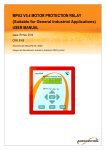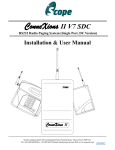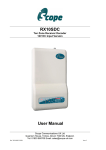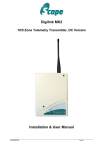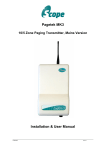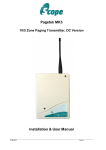Download scope MPA3 User manual
Transcript
MPA3 Mobile Personal Alarm MK3 User Manual Scope Communications UK Ltd, Quantum House, Totnes, Devon TQ9 5AL United Kingdom Tel: +44(0)1803 860700 Fax: +44(0)1803 863716 www.scope-uk.com MPA3 Page 1 of 11 Issue 1 PREFACE Important Installation Information It is the purchasers’ responsibility to determine the suitability of this equipment and its derivatives for any given application, Scope cannot give specific advice in this manual, as each use will require independent evaluation. Scope has, wherever possible, employed extra safeguards to monitor the system’s performance. Certain system installations, operational requirements or budgets may, however, limit the effectiveness of these safeguards. Again, the suitability of the system for any given application must therefore be decided by the installer and their customer, relative to the application and risk. Good working practice dictates that a suitable system installation log must be generated, together with a record of the dates when the system has been manually checked, (with the aid of signal strength meters etc.) enabling the system performance to be compared with the original installation data. For UK equipment, Scope has no control of the use and application of the frequencies issued by OFCOM. Some equipment that is licensed may have greater protection than other equipment which is operated on a WT Act License Exempt basis. The supply of this equipment is governed by our standard terms and conditions of sale, which can be found on the reverse of all order acknowledgements*, proforma invoices*, delivery notes, price lists and invoices. Alternatively, these can be provided on request. * Faxed proforma invoices and quotations refer to “conditions available upon request”. Licence For the UK, this equipment is intended for use on the 433 and 458 MHz Short Range Device licence exempt radio frequencies and programming has been restricted to these ranges. For use in the USA, this equipment will require a licence. Consult your dealer for further advice. For further technical rules governing the use of this equipment you should obtain the FCC Rules and Regulations, Title 47 Part 80 to end, including parts 90 and 95 available from the US Gov Printing Office, GPO Book store, FCC Office or www.fcc.gov/oet/info/rules/ . The FCC ID for this equipment is: JRNUSAPENLINK Important Safety Information Scope products are designed to operate safely when installed and used according to general safety practices. The following requirements should be observed at all times. Do NOT subject this equipment to: Mechanical shock Excessive humidity Extremes of temperature Corrosive liquids This equipment is designed primarily for indoor use, and is designed to be water resistant unless expressly stated otherwise. It must not be used in classified Hazardous Areas, including areas containing explosive or flammable vapours. If in doubt, consult your local product dealer for further information. For cleaning purposes, only use a damp cloth, do not use alcohol or spirit based cleaning agents. This product contains a replaceable Lithium primary (non-rechargeable) battery. Adhere to cautionary safety information provided with or on the battery casing. Removal of covers from the equipment must only be undertaken by authorised service personnel who must ensure that the unit is correctly sealed afterwards. Failure to do so could undermine the units water resistance performance. MPA3 Page 2 of 11 Issue 1 PREFACE Equipment Applications It is the user’s responsibility to determine the suitability of the Scope products for any given application. Scope, including its subsidiaries and Distributors, cannot provide specific advice within this manual, as each application will require independent evaluation. Common sense dictates that certain applications may require back up systems to cover in the event of mains or equipment failure. All applications should be thoroughly assessed by the installer in conjunction with the customer so as to minimize risk. Scope has no control of the use and application of the frequencies issued by the FCC or OFCOM. Some equipment that is individually licensed may have a greater degree of protection than other equipment that is operated on a FCC License Assignment basis. The following information, however, may be of benefit. Equipment Testing Range tests should be carried out at least once a week on portable radio equipment, more often when critical criteria apply. This should involve testing the unit past the limit of its required working range. Good working practice dictates that a suitable system installation log, covering both portable and fixed equipment must be generated, together with a record of the dates when the system has been manually checked and/or serviced, (with the aid of suitable test equipment etc.) enabling the system performance to be compared with the original installation data. The frequency of the tests required will vary between applications. If portable equipment has been dropped or is worn by a person involved in an accident, the unit should be tested again before re-use. It must be stressed that the physical range tests are essential and that any construction work or movement of plant or equipment could alter the signalling capability of the unit. Radio equipment, like any other requires servicing from time to time to ensure that it is operating to its optimum performance. It is therefore essential that equipment is inspected and tested by authorized service centres at least once a year. Literature Scope Communications UK Ltd, the manufacturer, in conjunction with its distributors operates a policy of continual improvement, and therefore reserve the right to modify or change any specifications without prior notice. While every possible care has been taken in the preparation of this manual, Scope does not accept any liability for technical or typographical errors or omissions contained herein, nor for incidental or consequential damage arising from the use of this material. Liability Scope does not accept liability for any damage or injury, howsoever caused as the result of misuse of this equipment. It is the responsibility of the user to ensure that the equipment is operated in the manner for which it was intended and that it is the correct item of equipment for the required task. MPA3 Page 3 of 11 Issue 1 Warranty This product is warranted as free from defects of workmanship and materials for a period of one year from the original purchase date. During this time, if there is a defect or malfunction of this product, Scope will, with proof of purchase, repair or replace at its discretion any defective parts, free of charge. This does not include where the adjustments, parts and repair are necessary due to circumstances beyond the control of Scope, including but not limited to fire or other casualty, accident, neglect, abuse, abnormal use or battery leakage damage. There are no other expressed or implied warranties except as stated herein, and those excluded include those of merchantability and fitness for a particular purpose. In no event will Scope or any of its agents be liable for direct, indirect, special incidental or consequential damages resulting from any defect in the product, even if advised of the possibility of such damages. The warranties and remedies set forth above are exclusive and in lieu of all others, oral or written, expressed or implied. No Scope distributor, dealer, agent or employee is authorized to make any modification, extension or addition to this warranty. Some states do not allow limitations on how long an implied warranty may last and some states do not allow exclusions or limitation of incidental or consequential damages. WARNING! SAFETY The Lithium battery in this product is NOT rechargeable! Only replace batteries with the correct type and do not attempt to recharge. DISPOSE OF USED BATTERIES ACCORDING TO THE INSTRUCTIONS. © Scope Communications UK Ltd, 2012 All Rights Reserved MPA3 Page 4 of 11 Issue 1 Introduction The MPA3 is a low power Pendant transmitter and is part of a range of Short Range Device products manufactured by Scope Communications UK Ltd. It is intended to be used in portable applications that require radio alerts on demand from a user or automatically in the event of a fall or "man down" scenario*. * dependant on unit's programmed configuration. Frequency can be programmed from 430MHz - 460MHz with a power output of 10dBm. Standard Scope radio protocol is transmitted to receiver devices and so can be used direct to pagers, although other protocols can be used on request. Device Functionality Removable Lithium battery power source. 2 triggers that can be configured for Normally Open, Normally Closed, or Toggle operation with multiple repeats and a configurable repeat timer. Configurable "repeat until cancel" mode. 3 axis accelerometer for Fall Detection, Shock Detection, ,Motion Detection or Tilt Detection. Call cancelling using magnetic wand. Configurable Test Call timer function. Note : This is a low power device designed to for long life and minimal power consumption. Device settings can have a considerable impact on the battery life. 3 Ancillary devices accompany the MPA if required. An MPA programmer used to configure the MPA3. This is a contact free device powered by USB that connects to the application software running on a PC. The MPA3 programmer is a write only device An MPA "Read" cable that the user can use to connect to the MPA3 and read the device configuration. An MPA docking unit that allows the user to safely store the MPA3 when not being used and which automatically turns off the Accelerometer (if configured) and turns it back on when removed from the device. These units can be purchased separately if required, they are not required for the MPA3 to operate as the device can be configured to the user requirements in the factory. MPA3 Page 5 of 11 Issue 1 Operation Front Button The front panel button is the primary alert method on the MPA3. When pressed it will send the pre-programmed alert message to the pager and/or fixed receiving unit. The button can be configured to repeat the message up to 4 times, configured in 5 second intervals up to 255 seconds. If the repeat function is configured and the button is pressed the button will not function until all the repeats have been transmitted or a cancel operation has been performed (see below). If the repeat function is not configured, an internal button inhibit filter does not allow the button to function again for 30 seconds after a button press. Note: if the front button is continuously pressed for greater than 3 seconds a secondary message is sent to pager address 0000008 indicating the firmware revision number. This is for dealer/engineering use only. Necklace Button An internal button is connected to the MPA3 neck cord. When this cord is pulled from its socket the device will transmit a message to indicate that the cord has been disconnected. This message is continuously transmitted at configured intervals until the cord is placed back correctly into it's socket. This is not cancelled by the "Cancel" operation described below. Cancel The MPA3 incorporates a magnetic reed switch so that messages can be acknowledged and cancelled when attended to. A magnet is used to activate the reed switch by placing the magnet against the side of the case as shown in the picture below. This sends a message to confirm that the alert has been acknowledged and cancels any pending button repeat alerts or accelerometer alert. If the users holds the magnet to the side of the Pendant casing for longer than 3 seconds, the accelerometer is switched off so that the unit can be placed in sleep mode when not being used. When the magnet is held to the side of the case for more than 3 seconds again then the accelerometer is turned back on. A message is transmitted to confirm the current state of the accelerometer. If the device has not been configured to use the accelerometer then the “Accelerometer off “ message only will be transmitted. Accelerometer The MPA3 can be configured for specific functions of motion, tilt and shock and some combinations thereof. Valid configurations are : Shock Only Motion Only Shock and Motion Shock and Tilt Shock and Tilt Shock, Motion and Tilt. Motion and Tilt have a configurable time out associated with them and the device must fulfil the Motion/Tilt requirements for all of the configured time to register an event. Note that the order of detection is Shock, Tilt, Motion. In order for the unit to be configured as a fall sensor the tilt function works on the fact that the unit is under the set tilt angle for the time out period. If the unit tilt angle is set to 45o, then if the unit is tilted below this angle and stays there for longer than the time out value then this constitutes a tilt event. The reference angle for all tilt measurements is the horizontal plane. If the unit is lying flat with the front button facing towards the ceiling then this is the zero angle reference and any set tilt angle is with reference to this position. Tilt is measured left or right, up or down. Motion and shock is measured on all 3 axis. When an accelerometer event is triggered a message is transmitted every 30 seconds until the event is cancelled. The LED will flash rapidly indicating that the device is in the triggered state. Whenever the accelerometer is configured to measure the values listed above, the LED will briefly flash every 5 seconds to indicate to the user that the accelerometer is active and measuring. MPA3 Page 6 of 11 Issue 1 Note: Whenever the Pendant is triggered, the front LED is illuminated to assure the user the message has been sent. If the battery is low when ever a message is sent, a battery low message will be transmitted first to indicate to the user that the battery needs replacing. When 8 consecutive low battery messages have been sent, a "shut down" message will be transmitted and after this point the unit will not transmit until the battery has been changed. Configuring the unit is done by the application software and a Pendant programmer unit. The pendant programmer provides a docking station for the pendant and a contact less method of unit configuration. The unit cannot be read in this programmer unit, only written to. Pendants can be factory configured to customer requirements. If the MPA3 configuration needs to be read (generally only a factory function), the MPA3 can be supplied with a USB "Read" cable which, when used in conjunction with the application software, can be used to read the MPA configuration data. In order to connect the cable, the MPA3 needs to be opened and connected to the appropriate header. If this function may be required, please consult Scope. MPA3 Page 7 of 11 Issue 1 Programming Software Installation. Do not connect the Base Programmer unit until the software has been installed and the required USB drivers have been installed. Software Insert the CD supplied with the unit and allow the auto run function to complete. Select “Install PND Software” option and allow the software to install to the default location unless there is a good reason not to do so. A standard set up file is also included in the installation. Drivers When the installation has finished, select the “Install USB drivers option” and allow the software to install. The user manual is installed as a Windows compiled help file that can be used in conjunction with the software. Software Start. Connect the device to the USB port via the supplied cable , ensure that the Red LED is on and the green LED is flashing every 2 seconds, this indicates that the device is ready to accept configuration parameters. If the LED's are not on/flashing at the required rate remove the USB cable and reconnect. If the LED is still not flashing then there is a potential problem with the device, contact technical support for further information. Note:- Do not disconnect the device from the USB port while a read from device or write to device is in progress as this could cause the device to stop functioning. Please ensure all other Scope USB devices are disconnected. From the Start/Programs/Scope menu select the Base Pendant Programmer to start the configuration program for the Pendant module. The software will detect the device connected, interrogate it and if validated will start up as shown below. The software can detect when the connection has been broken and will detect when the device is reconnected. Note that the command window indicates when the Pendant is verified. The device number and the Com port that it is associated with is shown in the right hand section of the software. If the Com port number is not shown, this indicates that the drivers are not installed properly or the wrong drivers are installed. If this is the case, please reinstall the drivers from the CD. Ensure the software indicates the device is connected. Note: 2 text files called User and Region are also required in the installation, these are automatically loaded at program start. Please do not try to alter these files as they are encrypted. FTDI Driver Test List Version CDM Date 2.00.00 Released Comments May 18th 2006 First stable release used by scope. Issued as an exe Install file. CDM 2.04.16 Feb 17th 2009 CDM 2.04.22 Nov 3rd 2009 Tested and released with application software. Issue as an exe Install file. Current driver set and recommended for new installs. CDM 2.08.02 Aug 11th 2010 Tested with Current application firmware. CDM 2.08.14 April 12th 2011 Most recent non beta version of the drivers. Users should upgrade to this driver version. Please note FTDI drivers are continuously being updated. Your PC may already contain drivers for FTDI Devices. Scope application software has been tested with the drivers allocated on the software package disk and selected previous driver releases. The driver test list is shown above. MPA3 Page 8 of 11 Issue 1 Specifications Pendant MK 3 Power Supply Primary Lithium Battery 1/2AA 3.6V (Removable, NOT rechargeable) Current : < 40mA (Transmitting @ 10mW) < 2uA (Sleep Mode) < 2.5mA (Read Mode) < 200uA in sampling mode (Accelerometer On) Temperature Range -20 - 55OC Operating -40 - 80 OC Storage Transmitter. Freq Range: 430 - 470MHz Frequency Accuracy: +/- 1.5KHz (maximum) over operating temp range. Note : Frequency Limitations do apply depending on Region/Country. Power Output : 10milliWatt (maximum). Channel Spacing : 12.5KHz @ 2.5KHz Deviation. Transmit Baud Rate : 512/1200 Transmit Protocol : POCSAG Low frequency Interface. (125KHz) Passive LF Receiver for non contact device configuration. (Configured Via Pendant Programmer). Accelerometer 3 axis accelerometer can be fitted in order to measure motion sensing/shock/tilt. Values can be configured using the application software. Can be configured for motion sense time, warning time and sensitivity. Consult Scope for requirements. Non Voltage Contacts. (*2) Configurable Message for each Contact (Up to51 Chars). Contact 1 Normally Open Contact Front panel Button. Latched Contact that will repeat the configured number of times if enabled to do so. Repeat Enabled (Up to 4 for each event).Repeat Time can be configured (5 - 255 Seconds in 5 second steps). Contact 2 Normally Closed Internal Contact connected to the Neck Cord. If the Neck Cord is broken then the unit will transmit repeatedly at the configured repeat time until the Neck Cord contact is repaired. Repeat Time can be configured (5 - 255 Seconds in 5 second steps) MPA3 Page 9 of 11 Issue 1 System Settings. Test Call Message (Up to 18 Hours Timer, Up to 51 Chars)(1) Reset Message (Up to 21 chars). Low Power Message (Up to51 chars) (2) Power Shut down Message (Up to 51 chars) (3) Motion Sensor Trip Message(Up to 51 chars) (If fitted) Contact Response Time = 10mS Min, 50mS Max Read switch Reed Switch Message to Cancel Ongoing Sensor Messages (Up to 22 Chars) Can be used to turn the Accelerometer On/Off when not used. Dimensions. (Including Case) Length = 60mm Width = 43mm Height =25mm 1: Not recommended For Low power Battery Applications. 2: When a Low Power event is detected, the transmitter output power is automatically reduced in order to maintain maximise battery life. 3: When the power can no longer support the Transmitter A power shut down message is transmitted. Compliance. R&TTE directive 1999/5/EC EMC Directive (89/336/EEC) EN 301 489-1 V1.4.1 Low Voltage Directive (73/23/EEC) EN60950 : 2000 ETSI EN 300 220-1 V2.1.1 (2006-04) ROHS II Compliant Copies of the Declaration of Conformity covering this product can be obtained from Scope FCC CFR 47 PART 90.213 FCC ID: JRNUSAPENLINK Scope’s policy is one of continuous development and specifications are subject to change without notice MPA3 Page 10 of 11 Issue 1 Pendant Programmer Power Supply Voltage : USB Supply. Current : < 100mA (LF Transmitting) Temperature -20 - 55OC Operating -40 - 80 OC Storage Dimensions. (Including Case) Length = .110mm Width = 85mm Height = 37mm Compliance. EMC Directive (89/336/EEC) EN 301 489-1 V1.4.1 ROHS II Compliant Copies of the Declaration of Conformity covering this product can be obtained from Scope FCC Part 15 This device complies with Part 15 of the FCC Rules. Operation is subject to the following two conditions: (1) this device may not cause harmful interference, and (2) this device must accept any interference received, including interference that may cause undesired operation. Scope’s policy is one of continuous development and specifications are subject to change without notice MPA3 Page 11 of 11 Issue 1












